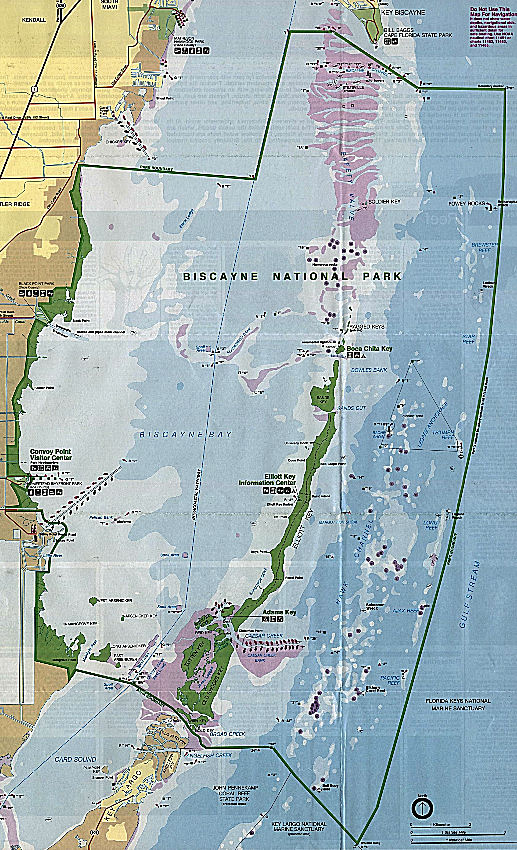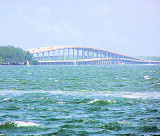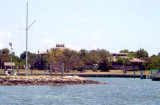

Elliot Key (Florida)
Keys (those 'keys' which are ancient coral reefs lifted above the present sea level), and the largest key north of Key
Largo. It is located entirely within Biscayne National Park.
It is bordered by the Atlantic Ocean to ...
| Latitude | Longitude | |
| DMS | --- | --- |
| DM | --- | --- |
| DD | --- | --- |

 Biscayne National Park, a protected area, is between Mile
Biscayne National Park, a protected area, is between MileThe park, located just 21 miles east of Everglades National Park, was established as a national monument in 1968. In 1980 it was enlarged to
181,500 acres and designated as a national park to protect a rare combination of terrestrial and undersea life, to preserve a scenic subtropical setting, and to provide an outstanding spot for recreation and relaxation.
It contains well-sheltered section of Biscayne Bay, about 45 low islands, called "keys," and about 20 miles of mainland mangrove shoreline.
Sea turtles are common in Biscayne Bay, feeding on the sea grasses on the shallow bay bottom.
Today, there is some harvesting of sponges is limited and the price of natural sponges has greatly increased.
At the center of Biscayne National Park are the coral reefs. Unlike the ocean depths, which are dark and nearly lifeless, the shallow water reefs are inundated with light and burgeoning with life. Brilliantly colorful tropical fish and other curious creatures populate the reefs.
The keys can be reached only by boat. Developed recreation areas and services are limited to a few islands. Boat fuel, supplies and food are not available on any island but are available at mainland marinas.
Only Elliott Key has drinking water.

 Biscayne National Park, une zone protégée, se trouve entre le point milliaire 1097,0 et le point milliaire 1119,2. Le National Park Service a établi une zone de mouillage au large de la pointe nord de Elliott Key, en face de Mile 1110,0. L'ancrage est marqué par des bouées.
Biscayne National Park, une zone protégée, se trouve entre le point milliaire 1097,0 et le point milliaire 1119,2. Le National Park Service a établi une zone de mouillage au large de la pointe nord de Elliott Key, en face de Mile 1110,0. L'ancrage est marqué par des bouées.Le parc, situé à seulement 21 miles à l'est du Parc national des
Everglades, a été créé comme un monument national en 1968. En 1980, il a été élargi à 181.500 hectares et désigné comme un parc national pour protéger une rare combinaison de la vie terrestre et marin, et préserver un cadre pittoresque subtropicale, ainsi que de fournir un emplacement privilégié pour les loisirs et la détente.
C'est la zone bien abritée de la baie de Biscayne, avec environ 45 îles basses, appelées «clés», et avec environ 20 miles de côte continentale en mangrove.
Les tortues de mer sont courantes dans la baie de Biscayne, se nourrissant d'algue sur le fond de la baie peu profonde.
Aujourd'hui, la récolte d'éponges est limitée et le prix des éponges naturelles a considérablement augmenté.
Les touches ne sont accessibles que par bateau. Les aires de loisirs et les services sont limitées à quelques îles. Bateau de carburant, fournitures et denrées alimentaires ne sont pas disponibles sur toute l'île, mais sont disponibles dans les marinas du continent. Seuls Elliott Key a l'eau potable.
Les récifs coralliens sont au centre du Parc national de Biscayne . Contrairement aux profondeurs de l'océan, qui est sombre et presque sans vie, les récifs des eaux peu profondes sont inondés de lumière et en plein essor avec la vie. Des poissons colorés tropicaux et autres créatures bizarres peuplent les récifs.
Ebook | Gulf of Mexico
|









